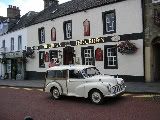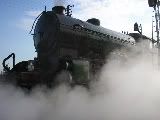Dave, the Rover V8 engine is actually very little heavier than the standard 2 litre, due to all alloy construction.
While uprated springs are often fitted (200lb spring rate is common) the reason is not so much to take extra weight, but to firm up the ride which many consider too soft on standard springs.
On standard suspension set ups the ride height is not adjustable. Sometimes the springs are not only uprated but shorter, to lower the ride height. If you car has had lowered springs fitted at the front then this could explain why the front hits bumps etc.
Shorter springs are not a good idea at the rear of the car, as the spring is only held in place by it's own tension. A shortened spring on the rear can actually fall out when the suspension is fully extended - I have seen it happen! Of course this wont happen on the front as the spring is fitted to the strut.
To test your shocks, you should be able to push down hard on each corner of the car, & it should bounce back then stop. If you cannot push it down or if continues to bounce up & down on the rebound, then the shocker may be faulty. The original shockers were not the best, so very often Spax or Konis or AVOs are fitted, and any of these can have adjustable damping for fine tuning the ride & handling to your liking.
Have a look under the car - you should be able to spot after market shockers if you clean the crud off them! Replacement springs are often painted red for some reason, factory springs were black with a coloured stripe to indicate the rating.
Tony

<font size="1">1981 2L FHC Cavalry Blue
1980 3.5L V8 DHC Jaguar Regency Red - sadly sold!</font id="size1">








